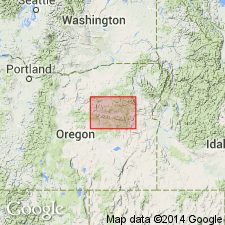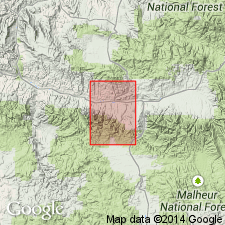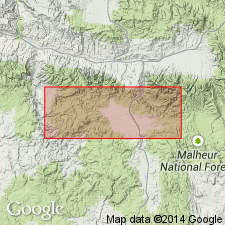
- Usage in publication:
-
- Laycock Graywacke*
- Modifications:
-
- Named
- Dominant lithology:
-
- Graywacke
- Shale
- AAPG geologic province:
-
- Blue Mountains province
Summary:
Laycock Graywacke, second oldest formation of Aldrich Mountains Group (new). Lower part consists of coarse- to medium-grained graywacke and black shale. Upper part is more shaly and tuffaceous; grades westward into tuff and feldspathic graywacke. Thickest known section, from Laycock Creek eastward beyond Hanscombe Mountain, estimated to be 11,000 feet. Base of formation faulted off in Laycock Creek. To west, grades downward lithologically into the Fields Creek Formation (new) of Aldrich Mountains Group with increasingly stronger folding. Conformable with overlying Murderers Creek Graywacke (new) of Aldrich Mountains Group. Age is Late Triassic(?).
Well exposed in roadcuts along Highway 395 between Canyon Creek and Bear Valley. Named for exposures in upper drainage basin of Laycock Creek, in southeast quarter of Mount Vernon 15-min quadrangle, Grant Co., northeastern OR. [According to GNU records (USGS DDS-6; Menlo GNULEX), type locality not designated.]
Source: US geologic names lexicon (USGS Bull. 1350, p. 419); supplemental information from GNU records (USGS DDS-6; Menlo GNULEX).

- Usage in publication:
-
- Laycock Graywacke*
- Modifications:
-
- Revised
- AAPG geologic province:
-
- Blue Mountains province
Summary:
Mapped in Mount Vernon 15' quad, Grant Co, OR. Consists of graded graywacke, tuffaceous graywacke, shale and conglomerate. Thickness is as much as 11,000 ft in southeast part of quad. Includes newly named Ingle Tuff Tongue which is water-laid, dark-gray, feldspar-rich andesitic tuff and tuffaceous graywacke. Bouldery conglomerate also shown separately on map. Interfingers with and overlies the Fields Creek Formation (Aldrich Mountains Group). Interfingers with and underlies the Murderers Creek Graywacke (Aldrich Mountains Group). Age is Late Triassic(?).
Source: GNU records (USGS DDS-6; Menlo GNULEX).

- Usage in publication:
-
- Laycock Graywacke*
- Modifications:
-
- Age modified
- AAPG geologic province:
-
- Blue Mountains province
Summary:
Mapped in eastern Aldrich Mountains. Consists of graded graywacke, tuffaceous graywacke, shale, and conglomerate. Includes submarine slide lenses of dark-gray graywacke. Rock weathers spheroidally. Matrix contains volcanic crystal debris. Thickness is as much as 11,000 ft in southwestern John Day 7.5' quad. Unconformably overlies, grades into, or interfingers with the Fields Creek Formation. Conformably underlies the Murderers Creek Graywacke. Unconformably underlies Pleistocene and Holocene landslides deposits. Age is Late Triassic.
Source: GNU records (USGS DDS-6; Menlo GNULEX).
For more information, please contact Nancy Stamm, Geologic Names Committee Secretary.
Asterisk (*) indicates published by U.S. Geological Survey authors.
"No current usage" (†) implies that a name has been abandoned or has fallen into disuse. Former usage and, if known, replacement name given in parentheses ( ).
Slash (/) indicates name conflicts with nomenclatural guidelines (CSN, 1933; ACSN, 1961, 1970; NACSN, 1983, 2005, 2021). May be explained within brackets ([ ]).

